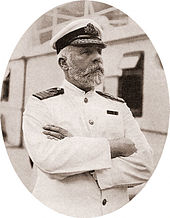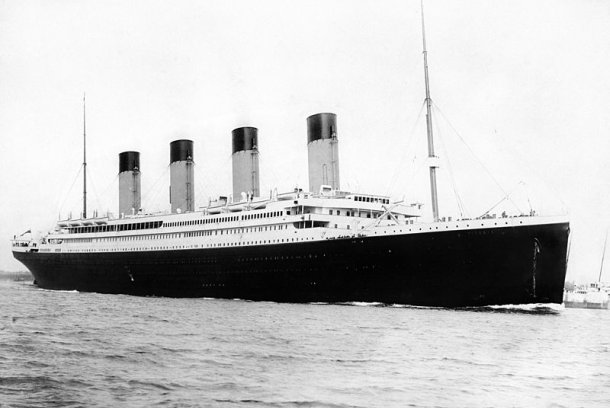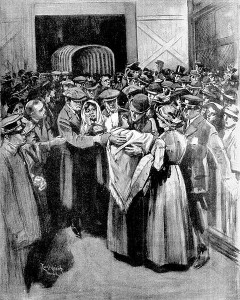The sinking of the Titanic was one of the great tragedies of the twentieth century. The tale has since evolved into a heady mix of fact and legend, a testimony to the enduring intrigue that surrounds this historic maritime disaster.
When the Titanic sank, some 1,500 passengers and crew drowned overnight, mainly because there was a massive shortage of lifeboats on the most luxurious sea voyager ever built.

Engraving by Willy Stower: Titanic sinking (Photo credit: Willy Stower)
When Did Titanic Sink?
The Date in ContextThe Titanic was expected to complete her maiden voyage on a transatlantic crossing from England’s Southhampton to the port at New York City, but she didn’t get far. When did the Titanic sink? Embarking from the UK on April 10, the world’s largest ship struck ice four days later. She was sucked into the cold Atlantic sea in the early hours of April 15, 1912.
While people have been sailing for millenia, ocean liners did not appear until the middle of the nineteenth century, when steamship technology made large-displacement ships possible. For the first time, we began to see big metal ships with looming smokestacks, staterooms, berths and boilers. It was a brave new age of oceangoing liners; boasts of ships’ incredible ‘modern’ capabilities were everywhere. The White Star Line and Cunard headed the pack as the two biggest steam-powered shipping companies.
By the time Titanic was conceived, sea travel was immersed in major shifts that emboldened naval architects to dream bigger. White Star’s Titanic was designed to up the ante in the marketing wars between major shippers. The jumbo, triple-propeller steamer was the world’s largest manmade moving object of any kind when it launched in 1912.
Titanic was in part designed to outpace Cunard’s Mauretania, the world’s fastest ship at the time. She also competed with the Lusitania, the second fastest–until it was sunk three years later, not by an iceberg but a hostile German U-boat on the eve of WWI.
Sailing Blind

Last lifeboat launched from the Titanic (Photo credit: Wikipedia)
A few swells would have helped light the bases of the area’s iceberg masses with phosphorescent plankton, but on such a quiet night, the sea was only motionless and dark. Some blame the lack of binoculars in the crow’s nest for missing the iceberg, but in truth there was nothing to peer at. The Titanic was sailing blind.
Captain E.J.

Edward Smith, captain of the Titanic (Photo credit: Wikipedia)
Even E.J. had dealt with his share of mishaps while trying to steer the new, high-displacement ships of the day. The last time he had manned a maiden voyage on a huge liner, he thrashed a tugboat with his enormous propellers while trying to maneuver the unwieldy Olympic into New York harbor.
The Premonition of the Titan

RMS Titanic departing Southampton on April 10, 1912.
In his novel, Robertson describes the voyage of a massive ocean liner named Titan, which crosses the Atlantic as fast as possible. The Titan collides with a massive iceberg en route and sinks, leaving many to drown due to its insufficient number of lifeboats.
Both the Titan and Titanic were described as the biggest ships in the world and marketed as record-breaking marvels. They were both around 800 feet long, had three propellers and two masts, and each launched and sank in the month of April.
Bonus Facts To Arouse Your Curiosity### "
Practically Unsinkable"Technically, the mammoth Titanic was never marketed as “unsinkable.” The phrase, made famous by lore and film, really came from a figure of speech taken out of context from the magazine Shipbuilder. In 1911, a reviewer had described the Titanic as “practically unsinkable” when its watertight doors were properly sealed.
Safety Technology
Even though little attention was paid to the basics, like having enough lifeboats, the Titanic was praised for its cutting-edge safety technology, including watertight compartments whose doors could be remotely activated. The collision with the iceberg, however, ruptured five of these watertight compartments, crippling their ability to lock out the gushing sea.
At the Edge of Retirement
Captain Smith, at 62 years of age, was ready for his retirement. The Titanic voyage was to be his last–even though it seems his employers at the White Star Line were already looking into postponing those plans. They wanted Smith to take the lead of Titanic’s even larger and more luxurious successor, the Gigantic, whose maiden voyage was scheduled for 2015.
Cheating Death
A handful of economic and political elites managed to cheat death on the Titanic by cancelling their accommodations before boarding. Henry Clay Frick, for instance, the steel magnate, booked and then gave up his Titanic suite to Wall Street baron J.P. Morgan–the man behind the conglomerate that owned the White Star Line and the Titanic.
J.P. Morgan decided he was too busy to travel, so he gave the room to fellow finance mogul J. Horace Harding, who let it become available to whatever poor soul would go in their places.
author: Editorial Staff categories:
- History date: 2013-06-24T20:25:48Z guid: https://curiosityaroused.com/?p=963 id: 963 thumbnail: wp-content/uploads/Arrival_of_the_ship_of_sorrow-420x470.jpg title: How Many People Survived the Titanic? url: /history/how-many-people-survived-the-titanic/
**_The Titanic - which sank April 15, 1912 - is remembered as the worst maritime accident in history, not only because the sinking of the ship itself was tragic, but because the hubris of the builders
who called the ship “unsinkable” - led them to include only enough lifeboats to salvage about half the passengers._**

“Arrival of the ship of sorrow”, published in the Boston Globe May 4, 1912.
How many people actually survived the Titanic sinking? There has never been a completely accurate passenger list for the Titanic - likely because of stowaways and last minute ticket swapping.
Approximately 2227 passengers and crew boarded the ship when she set out on her maiden–and final–voyage. Of those, 705 people survived the sinking of the ship, and 3 more of those perished on the way to Carpathia following rescue. That means that only 702 passengers and crew members survived, out of the approximately 2,227 passengers and crew.
Bonus Facts to Arouse Your Curiosity
1. The Titanic was the largest passenger ship for her time. More than three million rivets were used in her construction. She had a full-fledged hospital on board with an operating room for surgeries, a squash court, and an on-board swimming pool. While the accommodations for first-class passengers were quite nice, they were pretty awful for the lower fares. Third-class passengers had access to only two bathtubs, one for men and one for women. They had to be shared between 700 passengers!
2. What did the Titanic passengers eat as their final meal? In the first class, the menu was an eleven course dinner with several options including salmon, filet mignon, a chicken dish, a vegetable dish, lamb with mint sauce, roast duckling with apple sauce, and beef sirloin. Several options were available for appetizers and sides, and for dessert, passengers could choose between Waldorf Pudding, peaches in chartreuse jelly, chocolate and vanilla eclairs, and French ice cream.
3. There was a lot of food on board the Titanic, including 36,000 oranges, 1,750 quarts of ice cream, 1,500 gallons of milk, and 7,000 lettuce heads. There were also plenty of indulgences available, including 1,500 bottles of wine and 8,000 cigars.
4. Strangely enough, a novel in 1898 by Morgan Robertson, called Futility, seemed precognizant of the Titanic disaster. The book featured an 800-foot passenger liner called the Titan, which struck an iceberg on its starboard side in April. The ship sinks, and there are not enough lifeboats for all the passengers. Amazingly enough, it isn’t just the similar name of the Titanic that mimics the story. The liner was 882 feet in length, and struck the iceberg on its maiden voyage in April, and struck it on its starboard side. Both the real ship and the fictional ship were trying to break speed records when they sank.
5. While there were only 20 lifeboats on board the Titanic, there could have been 48. Why did White Star decide not to carry all the lifeboats that they could have? Aside from sheer hubris, they did it to save money and because to them, fewer lifeboats was more aesthetically pleasing. Imagine realizing you were going to your death because your cruise liner thought lifeboats weren’t aesthetically acceptable!
Those are just a few amazing items of trivia surrounding the Titanic. While it has now been more than a century since the sinking of the Titanic, the tragedy of this passenger liner continues to haunt the memories and imaginations of history buffs around the world.